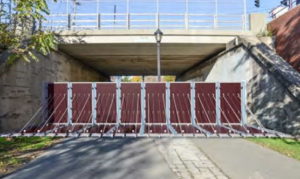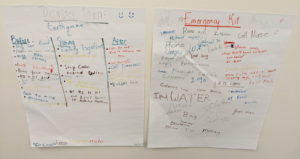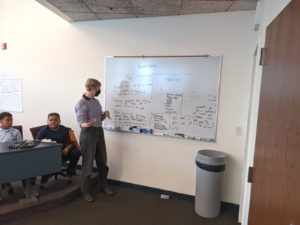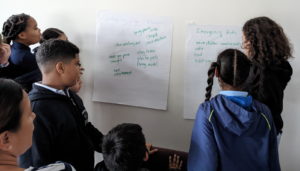On Friday, October 28th we had our third field trip of the year where the fourth grade class from the Rafael Hernandez dual English/Spanish language school came to learn about natural disasters and preparedness. Thank you to NEU volunteers for making this day possible: Stephanie, Erika, Jackson, Munin, and Maya.
The day focused on learning about natural disasters and natural hazards, looking at how they form and how we can prepare for them and mitigate the consequences. We briefly touched on Boston’s natural disaster plan – which is now over 300 pages. It’s actually being updated right now, so if you want to add your input, you can do so. We looked at vulnerable populations in Boston and how they might get impacted by rising sea levels and annual floods (you can explore this tool here). For our first activity we split into six groups and assigned each group one natural disaster: earthquake, blizzard, floods, heatwave, pandemic, or hurricane. Then, students were given 30 minutes to come up with a “Disaster Plan” – what to do before, during, and after their disaster as well as to come up with a list of emergency supplies they want prior to the disaster. After each group shared, we discussed commonalities and what an emergency kit ready for any disaster might have.
- Close-up of the Earthquake plan
- Munin shares about her group’s disaster plan and emergency kit supplies – for hurricanes
- Erika shares about her group’s disaster plan and emergency kit supplies – for blizzards
Next we envisioned a situation in which we were stuck at home with an approaching hurricane – a common occurrence in the south when residents don’t evacuate for whatever reason (fear, age, missing the news, etc). Stuck at home but warned of immense storm surge, we need to create (improvise) a personal flotation (why is this not spelled float-ation?) device. Students were given a wide range of materials to choose from (to simulate lightweight supplies found around the house) and had to create a flotation device to keep a can floating in a basin of water. Most of the devices kept the cans floating in the water, but many of them rolled to the side: note to future me: draw faces onto the cans (so we know if the “person” is floating face-up or face-down).
For our last activity, we looked at an existing design that Boston has for East Boston – the Greenway Flood Wall. This seven-foot high flood wall is temporary and deployable, i.e. it is only used when a flood is anticipated and on normal days is kept in storage. Taking inspiration from this design, students designed their own deployable levees,  creating designs for levees that can be placed and removed after the flood: using a plastic tub and various materials such as cardboard, plastic, sand, etc. The trickiest part of the activity is figuring out how to make the sand easy to add and remove – just dumping sand down isn’t very “deployable”, as you’d need some way to pick up all the sand particles afterwards (putting the sand in a plastic container is the best solution to this). In addition, the plastic bin, like roads in Boston (potholes), has little grooves that water can sneak through. To address this, the winning design (which lasted 40 seconds compared to the average 10 seconds) used duct tape in front of the levee to cover all these grooves. Lastly, we wrapped up the day with a college 101 panel with our student volunteers and a tour around campus.
creating designs for levees that can be placed and removed after the flood: using a plastic tub and various materials such as cardboard, plastic, sand, etc. The trickiest part of the activity is figuring out how to make the sand easy to add and remove – just dumping sand down isn’t very “deployable”, as you’d need some way to pick up all the sand particles afterwards (putting the sand in a plastic container is the best solution to this). In addition, the plastic bin, like roads in Boston (potholes), has little grooves that water can sneak through. To address this, the winning design (which lasted 40 seconds compared to the average 10 seconds) used duct tape in front of the levee to cover all these grooves. Lastly, we wrapped up the day with a college 101 panel with our student volunteers and a tour around campus.



